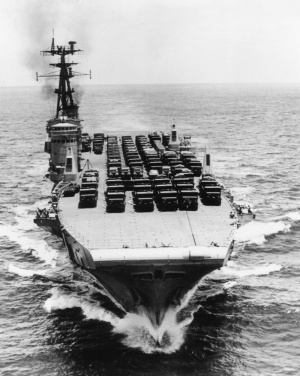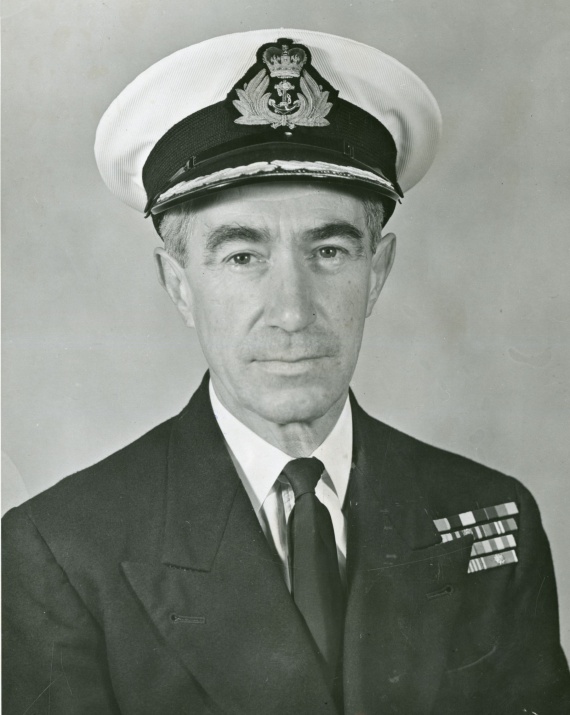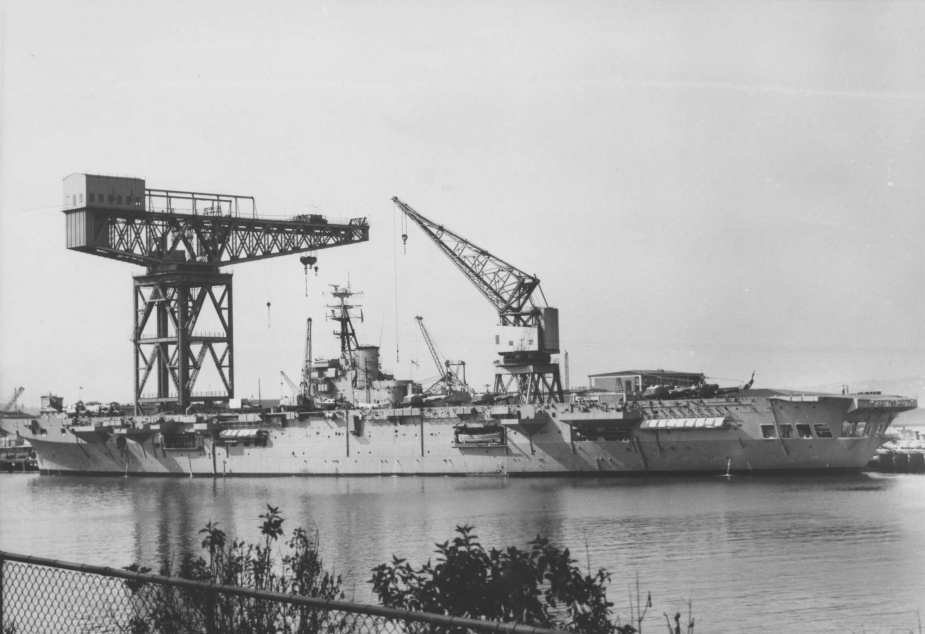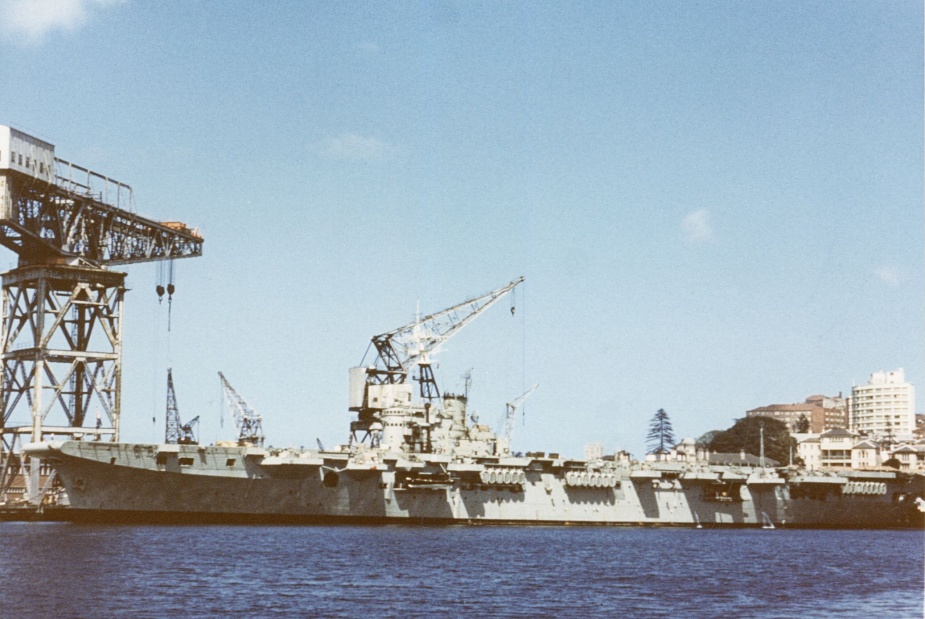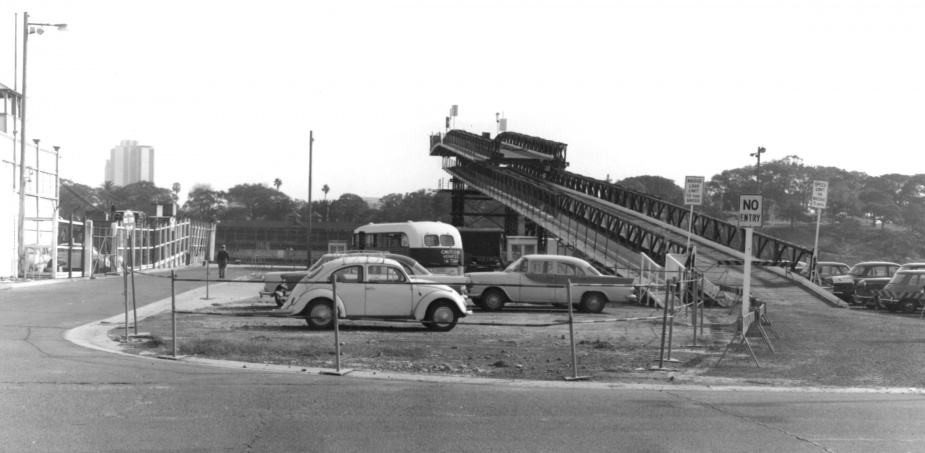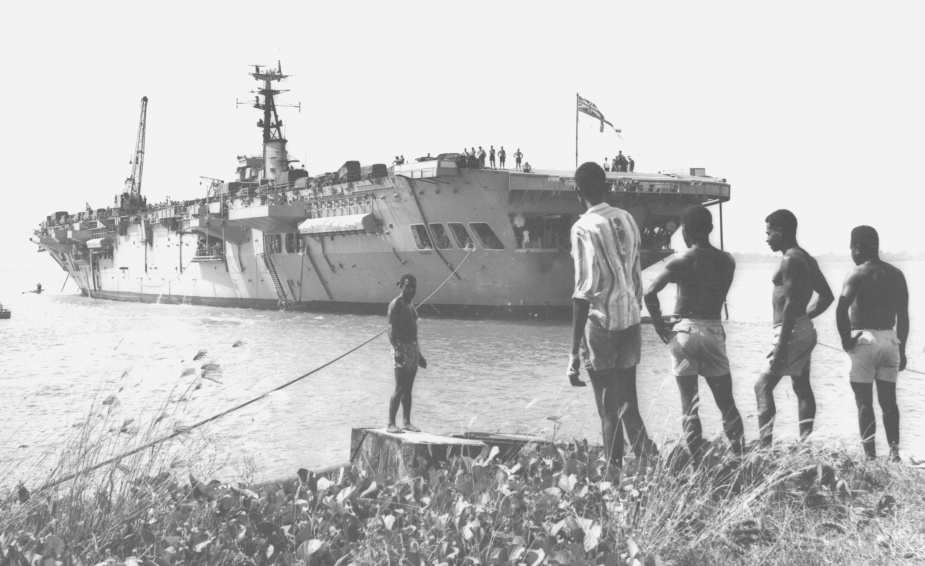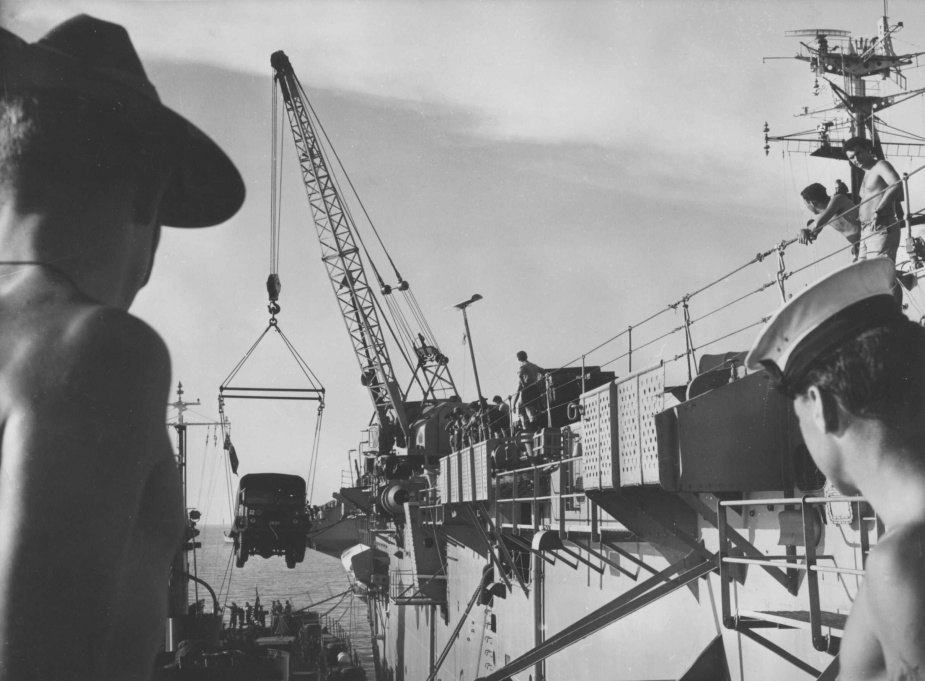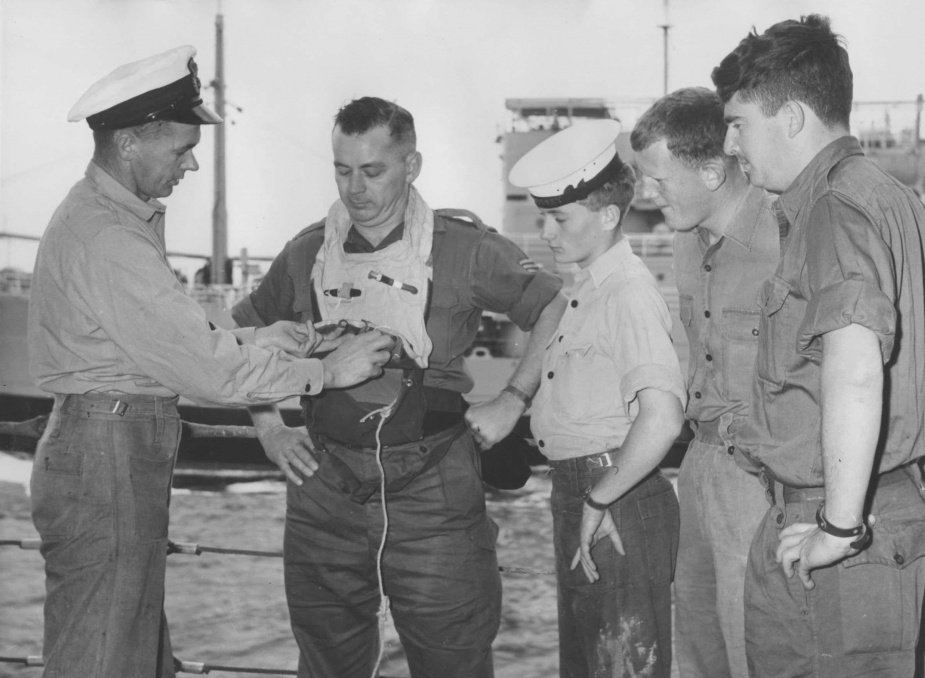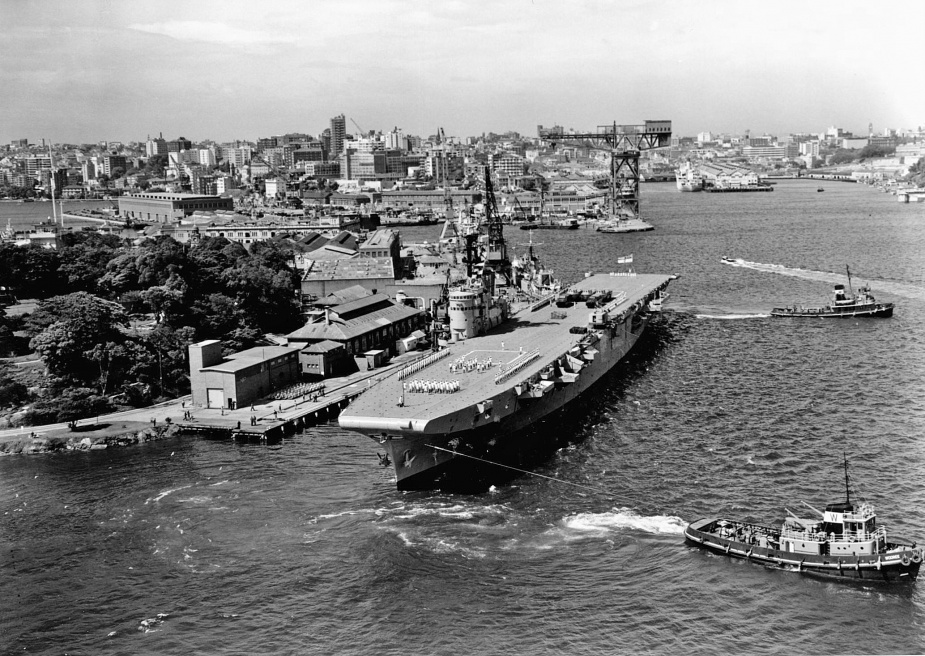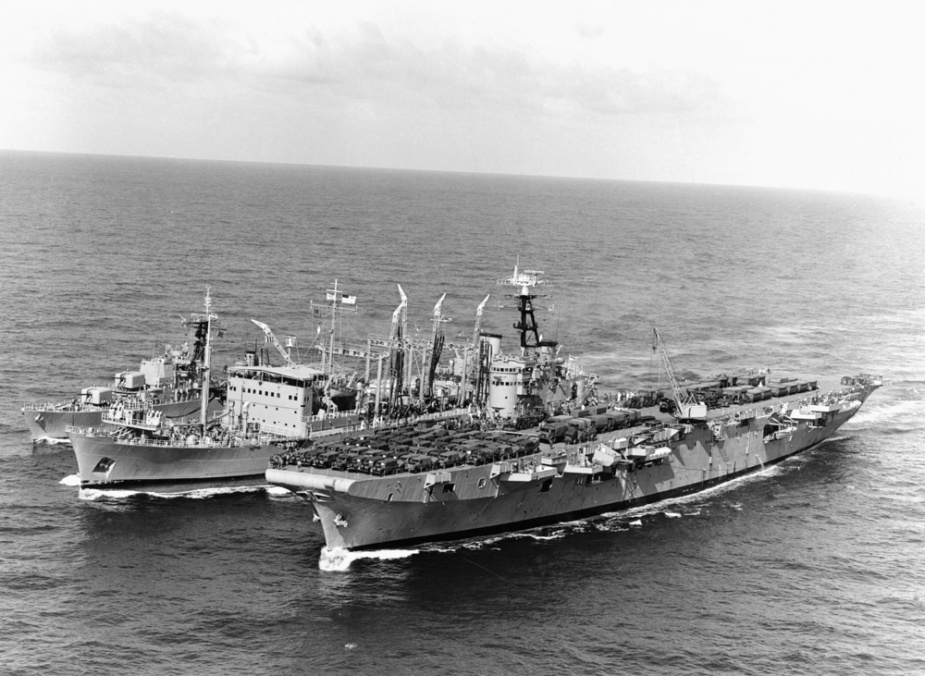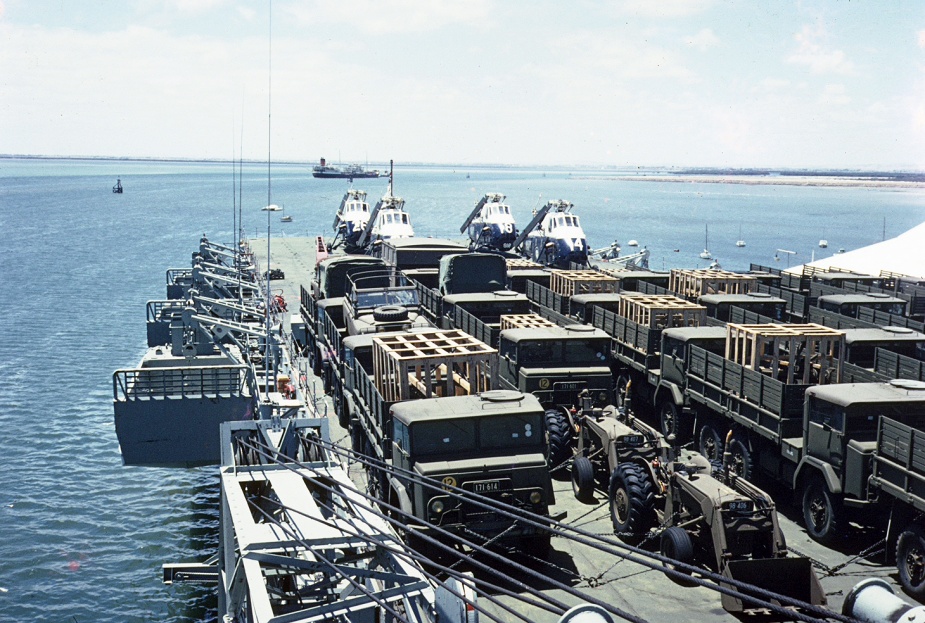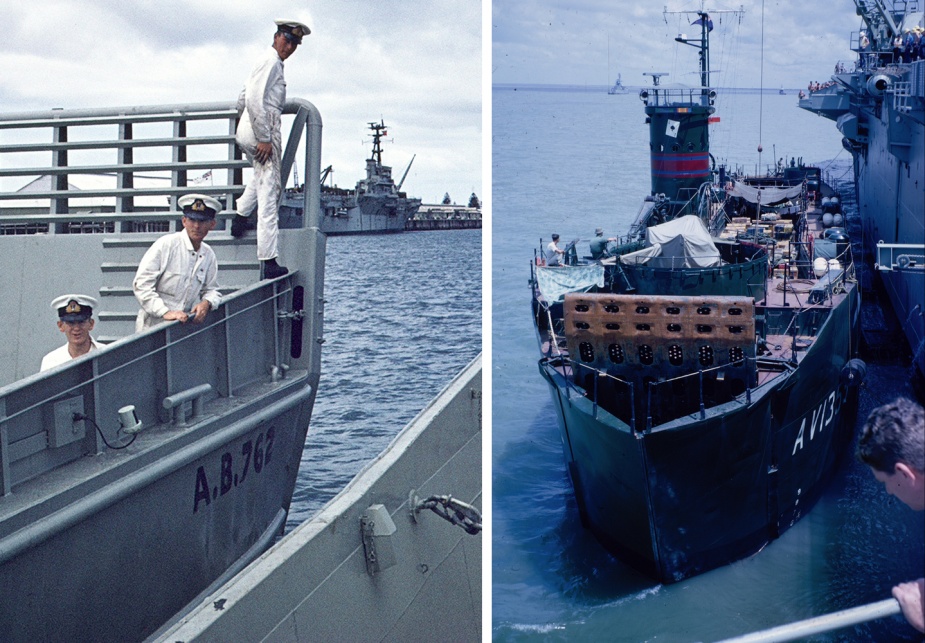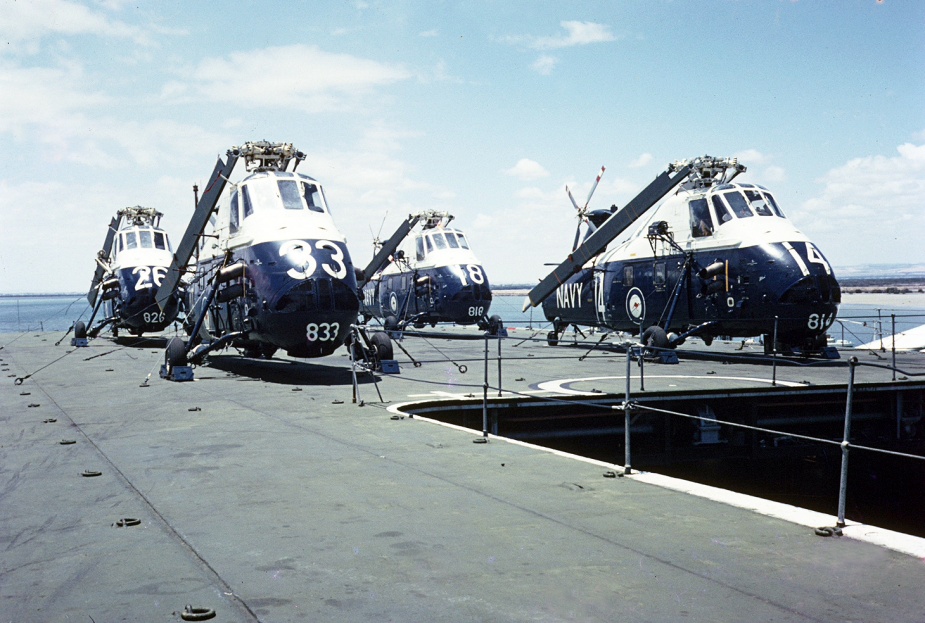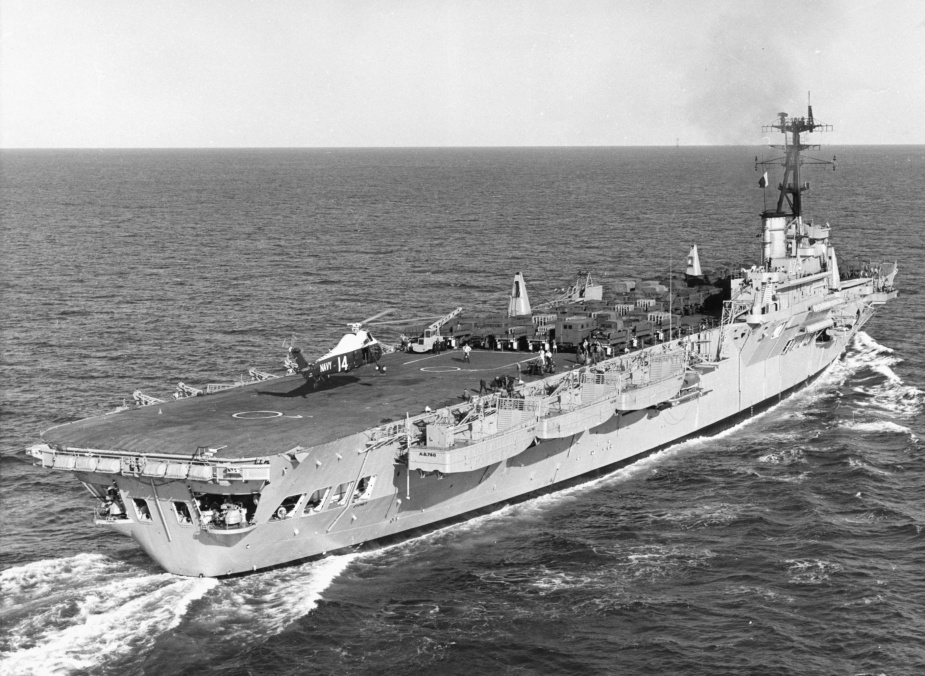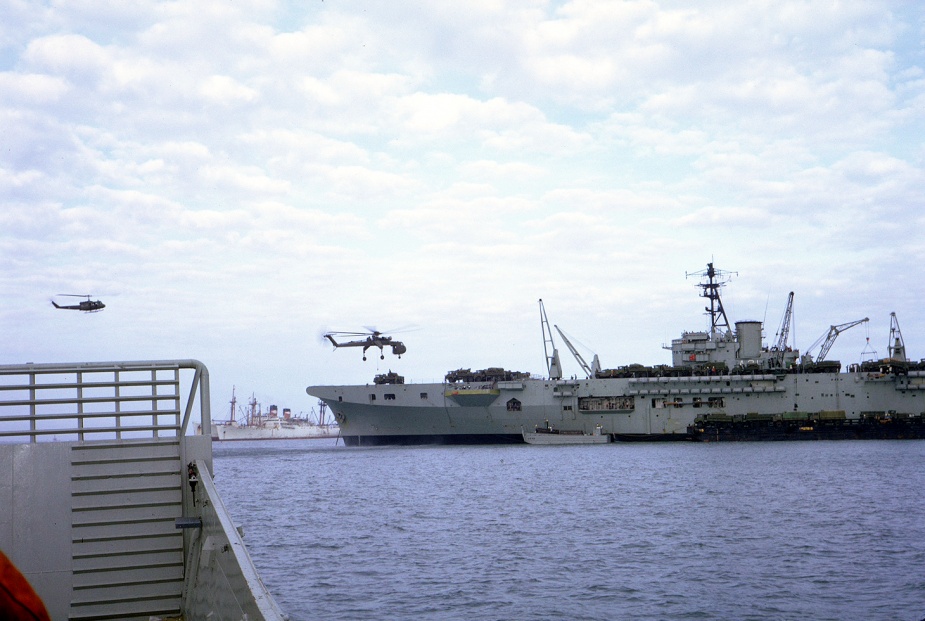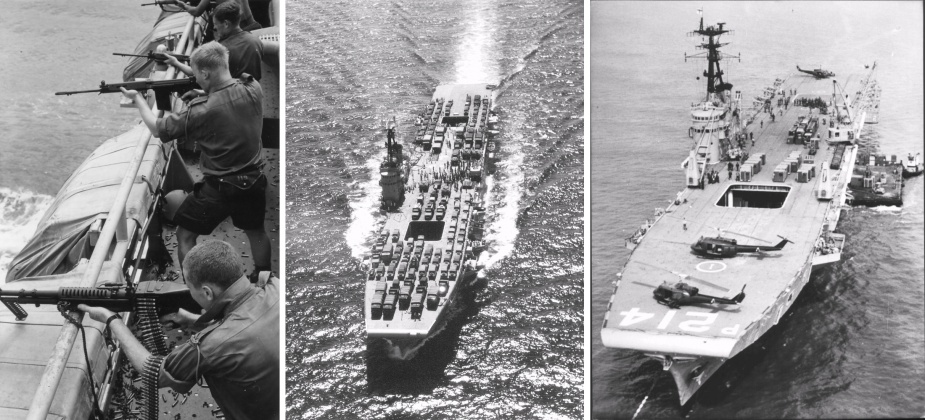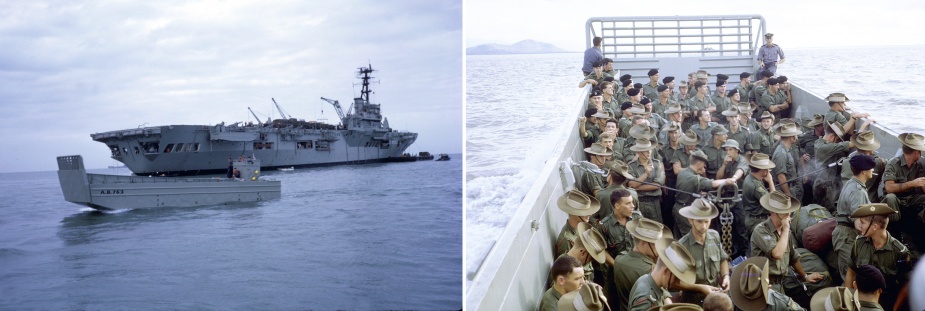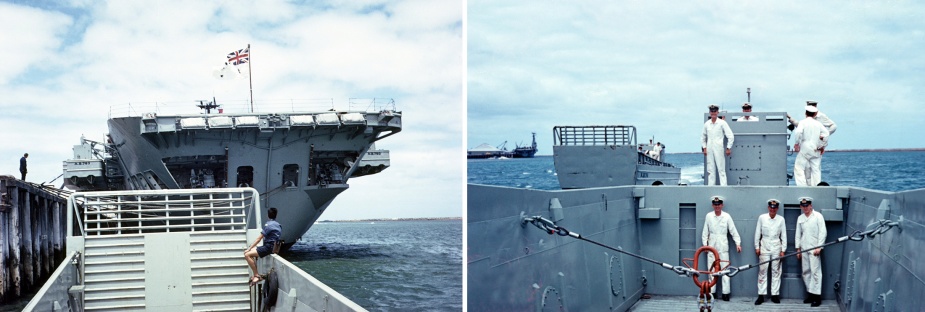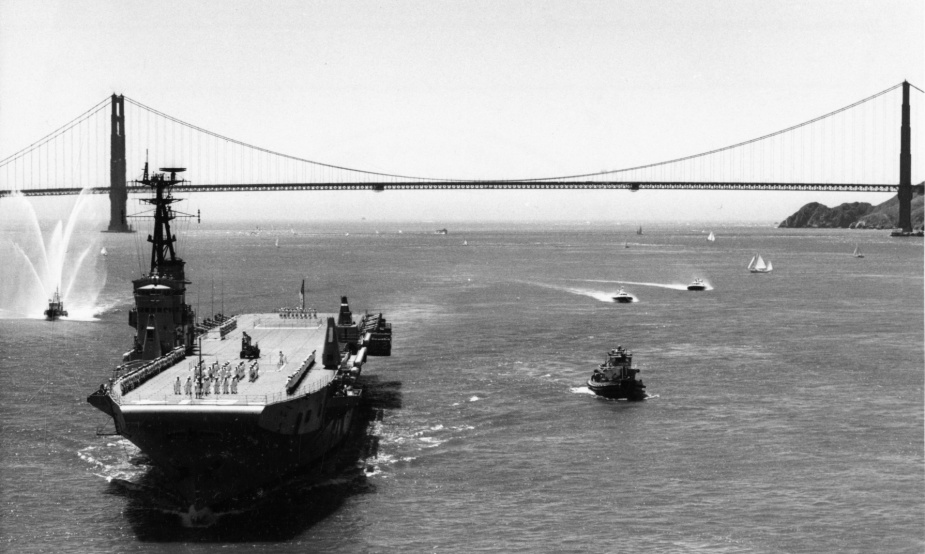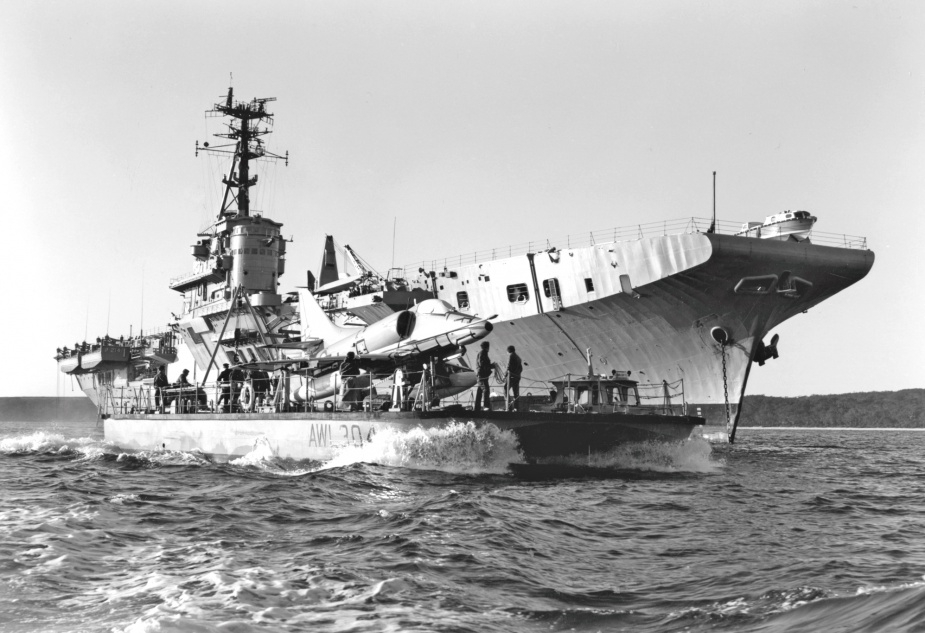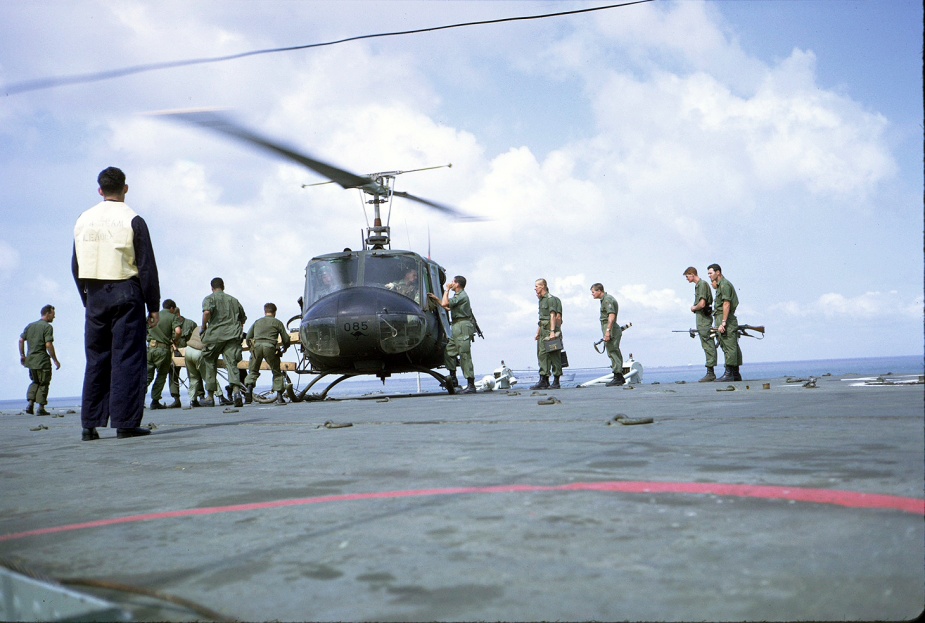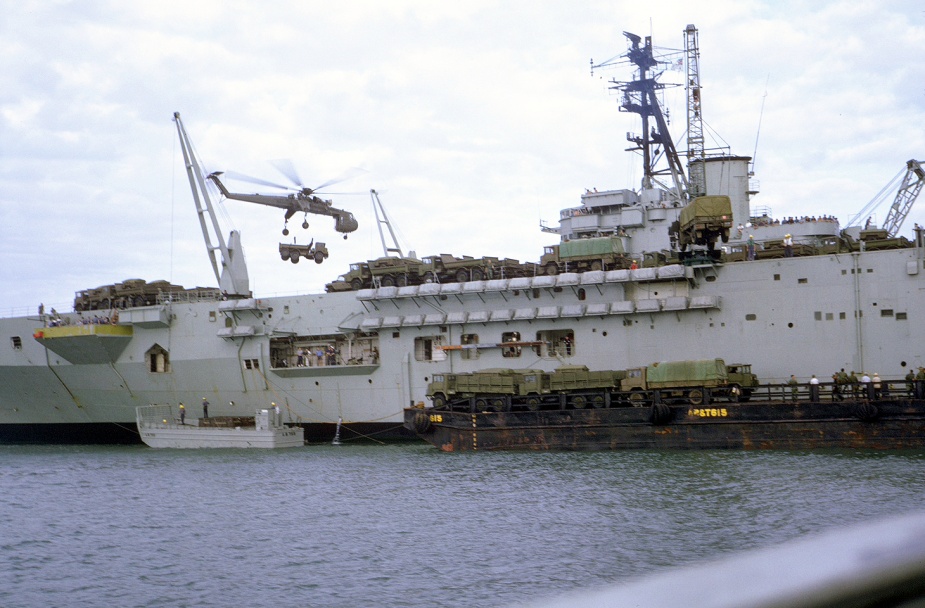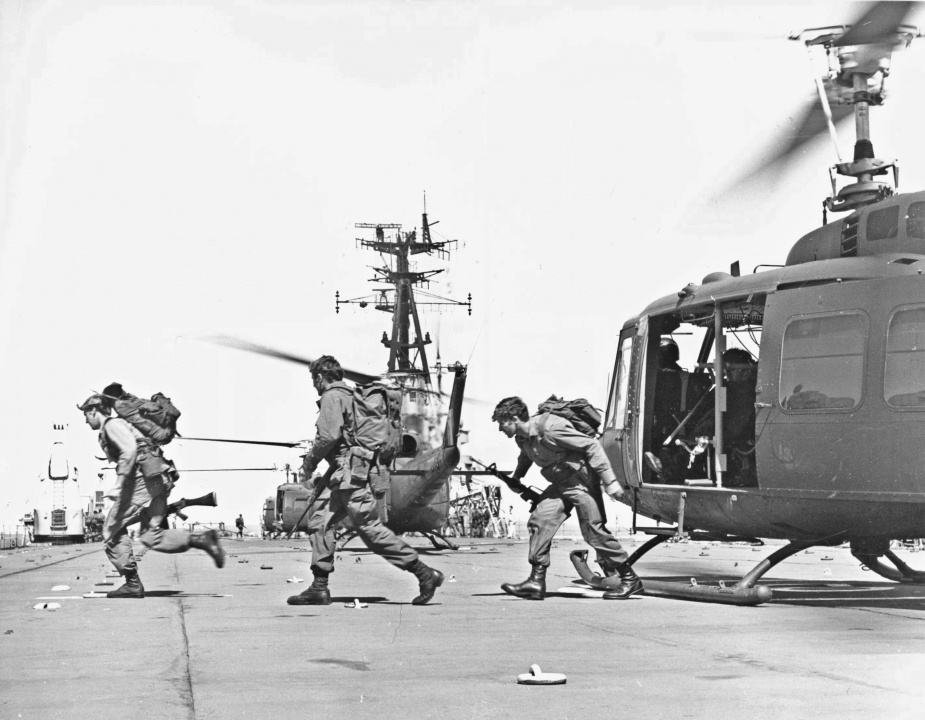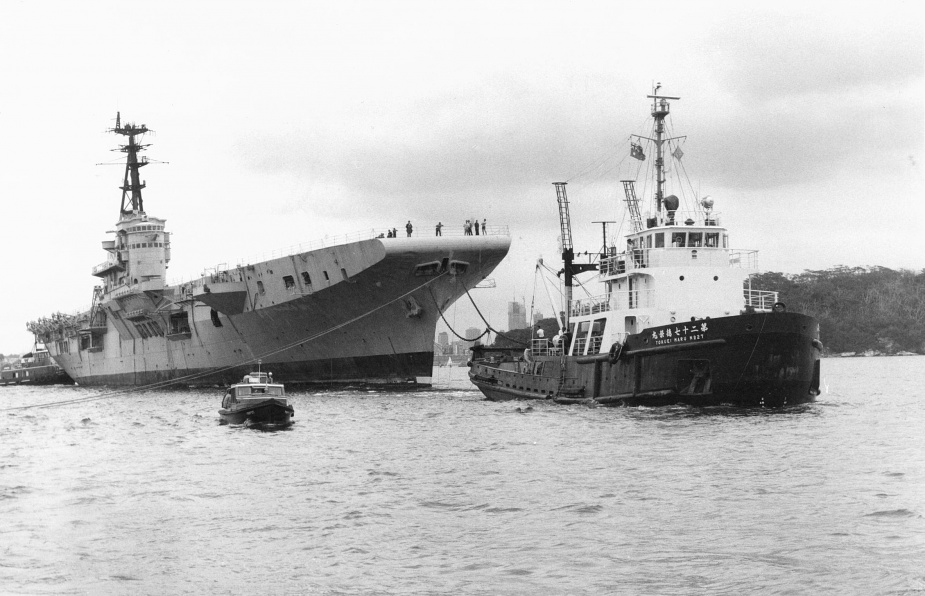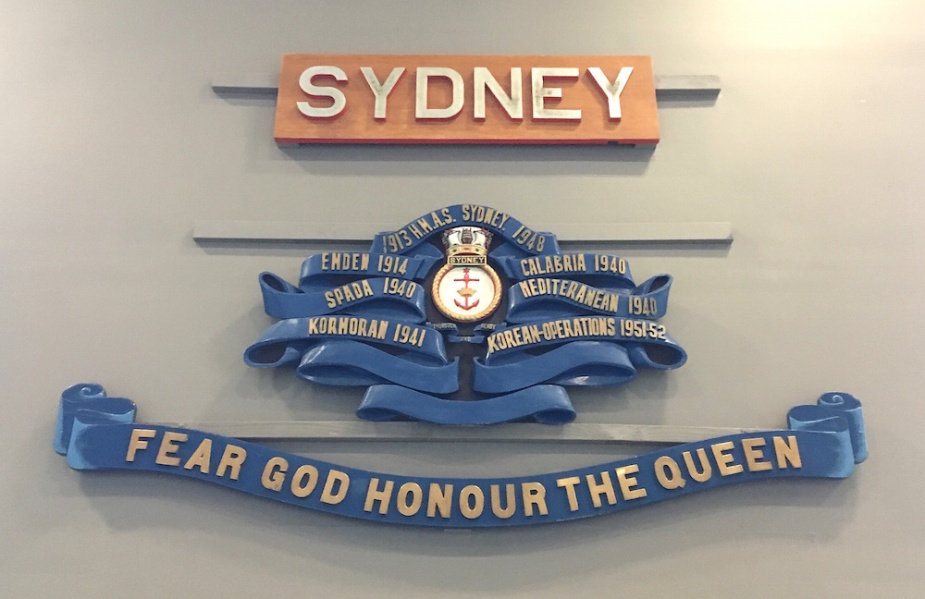HMAS Sydney (III) - Part 2
| Class |
Majestic Class |
|---|---|
| Type |
Aircraft Carrier/Fast Troop Transport |
| Pennant |
R17 later A214 |
| International Callsign |
VJLR |
| Nickname |
Vung Tau Ferry 1965-1972 |
| Motto |
Thorough And Ready |
| Builder |
HM Dockyard, Devonport, England |
| Laid Down |
19 April 1943 |
| Launched |
30 September 1944 |
| Launched by |
Mrs Duncan Sandys |
| Commissioned |
16 December 1948 |
| Decommissioned |
12 November 1973 |
| Fate |
Sold to Dong Kuk Steel Mill Co, Seoul, South Korea, and broken up |
| Dimensions & Displacement | |
| Displacement |
|
| Length | 696 feet (overall) |
| Beam | 80 feet |
| Draught | 25 feet |
| Performance | |
| Speed | 24 knots |
| Propulsion | |
| Machinery | Brown Curtis Turbines |
| Awards | |
| Inherited Battle Honours | |
| Battle Honours | |
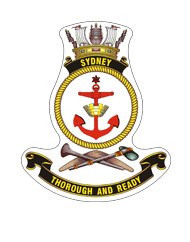
Between May 1958 and March 1962 HMAS Sydney (III) was berthed at Athol Bight near Bradleys Head where she was maintained in a reserve state by a small naval care and maintenance party. During that time a proposal was made for the ship to be reactivated as a base ship for the 16th Minesweeping Squadron, however, a feasibility study was to prove it impractical.
While the RAN no longer had a purely naval use for Sydney, the Australian Army expressed a view that in the event of either a limited war, or the need to counter insurgency, in Southeast Asia the former aircraft carrier would be of enormous value in the movement of not only troops, but also vehicles, ammunition and other stores and equipment. Strategic airlift capabilities at that time were insufficient to move even a small sized army battle group and the only serious option was sea lift. The Defence Committee deliberated on the proposal and, accepting that the movement of troops and equipment could not be accomplished by air, recommended that Sydney be brought back into service. Both the Minister for Defence and the Prime Minister approved the recommendation and Sydney was consequently taken out of reserve, refitted and reactivated as a fast troop transport, to be maintained at seven days' notice for sea.
Sydney recommissioned in her new role on 7 March 1962 under the command of Captain RI Peek, OBE, DSC, RAN, though she remained in refit for the rest of the year and into 1963.
Captain WJ Dovers, CBE, DSC, RAN relieved Peek on 27 September 1962 and was in command when the ship returned to full operational service as an active fleet unit on 1 July 1963. The occasion was marked by a ceremony conducted on the ship's flight deck that morning. She participated in Exercise CARBINE in Queensland waters in August and September before visiting Norfolk and Lord Howe Islands with the Governor-General, Viscount De L'Isle, embarked.
In October 1963 tragedy struck when one of Sydney's whalers (27 foot sail/row boat) failed to return from a training exercise conducted in the Whitsunday area in Queensland. The exercise involved junior officers independently navigating their boats on a course that would circumnavigate Hook Island before returning to the ship. The exercise took place over several days and was to prove much more difficult than anticipated due to strong currents, varying sea states and tides coupled with strong winds. The last boat to leave Sydney set off at appoximately 5:00am on Thursday 17 October carrying a crew of five. When it failed to return that evening a motor cutter was sent out to search for it but no trace could be found. Several other boats had by then also experienced difficulty with some being towed back to Sydney while the crew of another spent a night camping ashore. A search for the missing boat, involving several ships, was subsequently mounted and was discovered by HMAS Anzac dismasted and swamped approximately 100kms away on Monday 21 October.
The bodies of two of the crew were found in the boat and in spite of an intensive sea, air and land search lasting several days no trace of the other three young officers was found. Those who lost their lives in the tragedy were: Midshipman DJ Sanders, RAN, Midshipman GJ Pierce, RAN, Sub Lieutenant NJ Longstaff, RANR, Midshipman BH Mayger, RAN and Midshipmen PG Mulvany, RAN. The loss came as a severe blow to the crew of Sydney and the RAN Naval College.
In early 1964 Sydney underwent a brief refit in Captain Cook Dock at Garden Island. On 6 April Captain JP Stevenson, RAN assumed command and shortly afterwards he received orders to prepare Sydney to transport troops, equipment and aid to Malaysia as part of the Australian Army’s commitment to Confrontation. In light of the tensions associated with Indonesia’s opposition to the creation of the Malaysian State it was clear that there would be a need for tight security surrounding the operation and that the implementation of self-defensive measures would be prudent.
At that time Sydney was berthed at the Fitting Out Wharf (now Fleet Base East 1) and to expedite the storing of the carrier a temporary Baileys bridge was utilised to allow vehicles and stores to be driven from the dockside up onto Sydney’s flight deck. The bridge was to remain in situ for the next two decades servicing both Sydney and Melbourne before eventually being dismantled when both carriers were paid off.
As Sydney prepared for the forthcoming deployment a decision was made to retain some 200 ordinary seaman on board who were undergoing the sea phase of their initial training. Living conditions in the carrier were poor. It lacked adequate ventilation and there was limited room to rig hammocks, resulting in camp stretchers being used in any space deemed suitable to accommodate crew and embarked troops. In spite of that, morale was good as Sydney prepared for her first operational tasking since the Korean War.
After a brief shakedown cruise in waters of Jervis Bay, Sydney returned to the Fitting Out Wharf at Garden Island where the embarkation of deployment stores began at 08:30 on 18 May continuing around the clock until 22:30 on 20 May. Between 20-23 May the crew worked 16 hour days to ensure that all operational cargo was embarked and struck down within the ship. On 24 May army vehicles and personal were embarked via the Bailey Bridge and shortly after midnight the ship sailed with 1245 personnel on board.
Sydney steamed firstly to Manus Island where she briefly hove to on 30 May off Ndrilo Island before proceeding to a designated rendezvous with elements of the First Frigate Squadron, HMA Ships Parramatta (Captain RJ Scrivenor, RAN) and Yarra (Commander BH Loxton, RAN) which would then escort her to Jesselton, Borneo.
The ships maintained radar and radio silence en route and were darkened at night to avoid unwanted attention. On 1 June Captain Stevenson issued Operation Order 1/64 in which he set forth his appreciation of the situation and his intent concerning the safe passage and unloading of Sydney. His general policy was to evade detection and retaliate only in defence of an actual attack. As a precaution the embarked 111th Light Anti-Aircraft Battery was sited on the ship’s flight deck to supplement the ship’s armament while Parramatta was stationed 1000 yards ahead of Sydney and Yarra 1000 yards astern. Other precautionary measure included evasive steering and the closing up of defence watches.
At 13:00 on Thursday 4 June the ships arrived at their destination anchoring at Jesselton where disembarkation operations began utilising embarked army DUKWs assisted by the pre-positioned Australian Army landing ships medium (LSM) Harry Chauvel and Vernon Sturdee. The discharge of all personnel, vehicles, stores and equipment destined for Borneo was completed by 12:30 the following day.
At 01:00 on 6 June Sydney, preceded by her escorts, left Jesselton to rendezvous and replenish from RFA Gold Ranger before proceeding to Singapore. On 8 June Sydney anchored in waters off Singapore Naval Base where she discharged a further consignment of cargo via lighters. These operations continued until 11 June after which her crew was granted shore leave and a well-earned rest.
On 15 June Sydney sailed in company with Parramatta bound for Penang where they arrived the following day. There the remainder of Sydney’s cargo was discharged using army DUKWs and with the assistance of Vernon Sturdee which carried vehicles and guns from the 111th Light Aircraft Battery ashore. Ordnance and stores for the RAAF were also discharged on this occasion.
On completion of the disembarkation of all stores Sydney and Parramatta weighed anchor on 18 June proceeding via Sumatra for Fremantle. en route they maintained their defensive posture until early in the morning of 24 June. Sydney hove to off Geraldton on 25 June to embark customs officials before securing alongside in Fremantle on 26 June. Captain Stevenson was later to report that:
...the ‘Aid to Malaysia’ operation has been conducted with remarkably little difficulty although some problems arose with security, publicity and health in a hot crowded ship with poor ventilation. On the credit side the ship performed her new role better than expected and the spirits of the young men in the ship’s company, working defence watches and long hours in difficult conditions, remained very high throughout.
Sydney departed Fremantle on 30 June and was soon encountering rough weather as she encountered a south-westerly gale off Cape Leeuwin before shaping a course for Melbourne where she arrived on 5 July. Following a three day visit, during which short leave was granted to Sydney’s crew, the ship departed Melbourne undertaking a full power trial during the passage north to Sydney. She arrived in Port Jackson on 10 July for leave and maintenance.
The Vung Tau Ferry
On 29 April 1965 a decision was made by the Australian Government to commit an infantry battalion to serve in South Vietnam. Sydney subsequently received orders to make preparations to transport the 1st Battalion, Royal Australian Regiment (1RAR) to Vung Tau.
At that time, Sydney was alongside Garden Island in the throes of a refit. Work was curtailed and the ship quickly made ready to deploy. With 347 officers and men of 1RAR embarked, including vehicles and stores, Sydney departed Port Jackson in support of Operation TRIMDON on 27 May 1965. Her escort was the Daring Class destroyer HMAS Duchess and on 2 June they were joined by HMAS Parramatta. Two days later they rendezvoused with HMA Ships Melbourne, Vampire and Supply to replenish in waters south east of the Philippines.
As they continued the passage through the Philippines and across the South China Sea the task group closed up at Defence Stations. Melbourne’s Wessex helicopters were deployed in a screening role, her gannet aircraft flew anti-submarine patrols during daylight hours and Sea Venom fighters flew sorties at dawn and at dusk. Shortly after the task group entered the operational area in the early hours of 8 June 1965, Melbourne and Vampire detached, leaving Duchess and Parramatta to accompany Sydney to Cap St Jacques (Vung Tau).
Sydney and her escorts anchored at 07:00 on 8 June and cargo unloading operations began immediately, continuing until 11 June. On completion the task group proceeded to Singapore. Sydney returned to Vietnam in September 1965 in support of Operation TANTON. On that occasion she was initially escorted by HMAS Anzac and Melbourne before Duchess and Vendetta took over escort duties between Manus Island (Papua New Guinea) and Vung Tau.
On 8 March 1966 Prime Minister Harold Holt announced that Australia’s military commitment to Vietnam was to increase to a force of approximately 4,500 men. This force became known as the 1st Australian Task force (1ATF) and was based in Nui Dat, Phuoc Tuy Province.
During May and June 1966 Sydney was an integral part of Operation HARDIHOOD, the code name for the deployment of 5RAR and 6RAR to Vietnam. Two voyages were completed in support of HARDIHOOD and Melbourne, already on deployment in connection with the Far East Strategic Reserve, was again tasked as an escort. The efforts of Sydney and her ship’s company throughout 1965 and 1966 were recognised with consecutive awards of the coveted Duke of Gloucester's Cup for general and operational efficiency.
With Australian ground forces now well established in Vietnam, Sydney began a regular pattern of disembarking one battalion at Vung Tau and back loading another for the return passage to Australia. Although her escort had by then been reduced to a single ship, a detachment of four Wessex MK 31A helicopters from 725 Squadron was embarked in April 1967 to provide additional anti-submarine protection. The Wessex flight returned to its base at the Naval Air Station, Nowra, in June 1967, and was in turn replaced by a similar flight, from 817 Squadron, for the five voyages between December 1967 and December 1968. The detachment was usually drawn from a component of the Melbourne Carrier Air Group and those who served in Sydney gained valuable operational experience while the flagship was in refit or undergoing modernisations.
Sydney’s turnaround times in Vung Tau received a boost in 1967 when she was equipped with six LCM Mk 6 landing craft. Three each were secured outboard on her port and starboard sides below the aft section of the flight deck.
This added capability enabled her to reduce unloading times to an impressive six hours or less. This astounded US Army port authorities, as it routinely took merchant ships carrying a similar load of motor vehicles up to two weeks to discharge their cargos in Vung Tau.
Sydney undertook three voyages to Vietnam in 1967, four in 1968, three in 1969 and two in 1970. Her busiest year, however, was 1971 when she deployed to Vietnam on six occasions.
Living conditions on board were cramped for both her crew and embarked forces, and service in the tropics, with no air conditioning, made for an uncomfortable experience. In the first week of March 1971 there was an outbreak of Dysentery, with 323 cases reported. The outbreak of the disease, endemic to Vietnam, was attributed to the recently embarked 7RAR personnel. Overcrowding occurred whenever Army personnel were embarked, and this required many junior sailors to sleep in ‘A’ Hangar to free up mess deck accommodation for the troops. One of the more unusual aspects of Sydney’s war service was that many of the junior sailors were 16-year old junior recruits getting their first taste of life at sea.
Operation AWKWARD
While at anchor in Vung Tau, self-protective measures, collectively known as Operation STABLEDOOR, were employed by Australian and US ships. These measures provided a level of protection against the threat of waterborne attack. The RAN’s well established Operation AWKWARD routines provided an extra layer of protection against enemy sappers. This protection included the posting of armed upper deck sentries, additional lookouts, waterborne patrols and sweeps of the hull and anchor cables by ship's diving teams. Underwater scare charges were also employed as a deterrent against enemy swimmers.
Withdrawal phases and decommissioning - 1971 to 1973
In July 1971 Sydney visited the United States and Canada on a training and logistic cruise. At Esquimalt, Vancouver Island, she took part in the British Columbia Centennial Naval Assembly. On her departure for home she was carrying ten additional Skyhawk aircraft for the Fleet Air Arm, which had been embarked at San Diego.
By late 1971 the withdrawal of Australian forces from Vietnam had begun and for Sydney the focus shifted from rotating infantry battalions to bringing them home. In Vung Tau on 8 December 1971 Sydney embarked 4 RAR, the final battalion group, together with 104 Field Battery and 9 Squadron RAAF with its 16 Iroquois helicopters. The South Vietnamese President Nguyen Van Thieu flew on board to officially thank the Australian forces for their service in Vietnam and Sydney fired a 21-gun salute as the President departed.
Australia’s combat role in South Vietnam ceased in March 1972 when Sydney brought home the last combat elements. Sydney returned to Vung Tau for one final visit in November 1972, when she delivered a cargo of defence aid for Vietnam and Cambodia. Leaving Vung Tau on 24 November she set course for Hong Kong. En route the ship took in tow a disabled Panamanian merchant vessel, Kaiwing, and towed her to Hong Kong. After her visit to Hong Kong, Sydney returned to Australia.
After visiting Singapore in March 1973 and participating in an exercise after her return to Australia, Sydney proceeded to New Zealand, where she made calls during April to Wellington and Auckland. On return to Australian waters the ship took part in a joint services exercise.
On 20 July 1973 the ship’s company was informed that it had been decided to pay off Sydney instead of proceeding with a planned refit. On 12 November 1973 the ship decommissioned, by which time she had steamed 395,591 miles as a fast troop transport. Since first commissioning in 1948 she had steamed 711,549 miles.
Stripped of all useful fittings, Sydney returned to Athol Bight where she languished until sold for scrap to the Dongkuk Steel Mill Company, Limited of Seoul, South Korea, on 28 October 1975. The former aircraft carrier and fast troop transport left Sydney under tow on 23 December 1975.
Commanding Officers of HMAS Sydney (III)
| 16 Dec 1948 | Captain RR Dowling, RAN |
| 22 Apr 1950 | Captain DH Harries, RAN |
| 28 Apr 1952 | Captain HJ Buchanan, RAN |
| 12 Sep 1953 | Captain GC Oldham, RAN |
| 06 Jul 1955 | Captain WH Harrington, RAN |
| 07 Jan 1957 | Captain JS Mesley, RAN |
| 08 Apr 1958 | Commander NE McDonald, RAN |
| 07 Mar 1962 | Captain RI Peek, RAN |
| 16 Jun 1962 | Commander KW Shands, RAN |
| 27 Sep 1962 | Captain WJ Dovers, RAN |
| 18 Nov 1963 | Captain HD Stevenson, RAN |
| 06 Apr 1964 | Captain JP Stevenson, RAN |
| 04 Jan 1965 | Captain JG Crabb, RAN |
| 14 Dec 1965 | Captain AM Synnot, RAN |
| 19 Dec 1966 | Captain EJ Peel, RAN |
| 15 Jan 1968 | Captain DA Clarke, RAN |
| 13 Apr 1970 | Captain BS Murray, RAN |
| 02 Feb 1971 | Captain RJ Scrivener, RAN |
| 17 Jan 1972 | Captain JL Merson, RAN |
| 16 Jan 1973 | Captain AJ Robertson, RAN |
| 01 Oct 1973 | Commander AH Evans, RAN |

